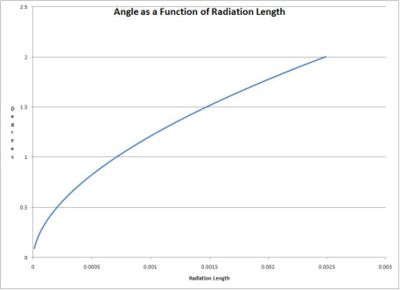Difference between revisions of "Multiple scattering Angle"
Jump to navigation
Jump to search
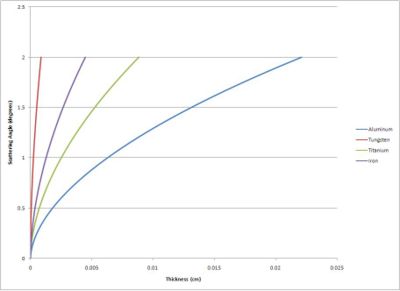
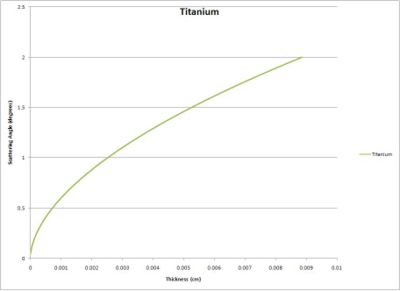
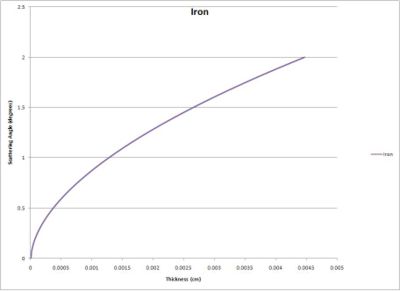
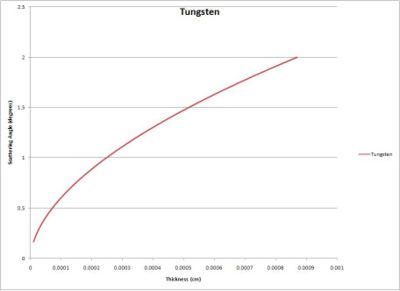
| (33 intermediate revisions by the same user not shown) | |||
| Line 1: | Line 1: | ||
| − | Angle as a Function of Radiation Length | + | [http://wiki.iac.isu.edu/index.php/HRRL Go Back] |
| − | [[Image:Theta vs Radiation Length.JPG]] | + | |
| + | |||
| + | =Multiple Scattering Angle= | ||
| + | |||
| + | <math>\theta_{0} = \frac{13.6 MeV}{\beta cp}z{\sqrt{x/X_{0}}}{[1+0.038ln{(x/X_{0})}]}</math> | ||
| + | |||
| + | p = momentum of the incident particle | ||
| + | |||
| + | <math>\beta</math>c = velocity of the incident particle | ||
| + | |||
| + | z = charge number of the incident particle | ||
| + | |||
| + | <math>x/X_{0}</math> = thickness of the scattering medium in radiation lengths | ||
| + | |||
| + | ==1.Angle as a Function of Radiation Length== | ||
| + | [[Image:Theta vs Radiation Length.JPG |400 px]] | ||
---- | ---- | ||
| + | ==2.Graphs of Angle vs. Radiator Thickness for various metals== | ||
Scattering Angle as a Function of Thickness | Scattering Angle as a Function of Thickness | ||
| − | [[Image: | + | {| border="1" cellpadding="20" cellspacing="0" |
| − | [[Image: | + | |- |
| − | [[Image: | + | [[Image:Al,Ti, W, Fe.JPG | 400 px]] |
| − | [[Image: | + | |- |
| + | [[Image:ATi.JPG | 400 px]] | ||
| + | |- | ||
| + | [[Image:FeL.JPG | 400 px]] | ||
| + | |- | ||
| + | [[Image:WRL.JPG | 400 px]] | ||
| + | |}<br> | ||
| + | ---- | ||
| + | |||
| + | ==3.Table of Radiator thickness for specific scattering angles== | ||
| + | Radiator Thickness given specific Scattering Angles: | ||
| + | |||
| + | {| border="1" cellpadding="20" cellspacing="0" | ||
| + | |- | ||
| + | |'''Radiator''' | ||
| + | |'''0.2 degrees''' | ||
| + | |'''0.3 degrees''' | ||
| + | |'''0.4 degrees''' | ||
| + | |'''0.5 degrees''' | ||
| + | |'''0.6 degrees''' | ||
| + | |- | ||
| + | | '''W''' || 0.15 microns || 0.3 microns || 0.5 microns || 0.7 microns || 1 micron | ||
| + | |- | ||
| + | | '''Fe''' || 0.7 microns || 1.4 microns || 2.5 microns || 3.6 microns || 5 microns | ||
| + | |- | ||
| + | | '''Ti''' || 1.4 microns || 2.8 microns || 4.8 microns || 7.2 microns || 10 microns | ||
| + | |- | ||
| + | | '''Al''' || 3.5 microns || 7.1 microns || 12 microns || 18 microns || 25 microns | ||
| + | |- | ||
| + | | '''Radiation Length''' || 3.9 E-5 || 8 E-5 || 1.35 E-4 || 2 E-4 || 2.8 E-4 | ||
| + | |- | ||
| + | |-<br> | ||
| + | } | ||
| + | [http://wiki.iac.isu.edu/index.php/HRRL Go Back] | ||
Latest revision as of 16:30, 10 June 2010
Multiple Scattering Angle
p = momentum of the incident particle
c = velocity of the incident particle
z = charge number of the incident particle
= thickness of the scattering medium in radiation lengths
1.Angle as a Function of Radiation Length
2.Graphs of Angle vs. Radiator Thickness for various metals
Scattering Angle as a Function of Thickness




3.Table of Radiator thickness for specific scattering angles
Radiator Thickness given specific Scattering Angles:
} Go Back| Radiator | 0.2 degrees | 0.3 degrees | 0.4 degrees | 0.5 degrees | 0.6 degrees |
| W | 0.15 microns | 0.3 microns | 0.5 microns | 0.7 microns | 1 micron |
| Fe | 0.7 microns | 1.4 microns | 2.5 microns | 3.6 microns | 5 microns |
| Ti | 1.4 microns | 2.8 microns | 4.8 microns | 7.2 microns | 10 microns |
| Al | 3.5 microns | 7.1 microns | 12 microns | 18 microns | 25 microns |
| Radiation Length | 3.9 E-5 | 8 E-5 | 1.35 E-4 | 2 E-4 | 2.8 E-4 |
